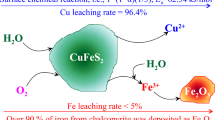Abstract
The anodic dissolution of n- and p-type chalcopyrite (CuFeS2) was studied in both acidic sulphate and acidic chloride media under conditions relevant to chemical leaching, i.e., at temperatures >70° C and over the potential region 0.2–0.6 V versus SCE. Double potential pulse chronoamperometry was used to probe the surface of the chalcopyrite anodes to determine the activation currents at various applied overpotentials. Analysis of the data obtained in both systems indicated the formation of a surface layer, a solid electrolyte interphase (SEI), which slows the rate of electron transfer. The electron transfer between various redox couples, including Cu2+/Cu2+, Fe2+/Fe2+ and I −3 /I− on n- and p-type chalcopyrite and on Pt, was compared using cyclic voltammetry. In the potential region of interest, the Fe2+/Fe2+ couple is much less reversible on chalcopyrite than are the Cu2+/Cu2+ and I −3 /I− redox couples. Chemical leaching of chalcopyrite in the presence of various oxidants was also carried out, and the results of the chemical experiments were discussed in terms of the electrochemical properties of the systems.
Similar content being viewed by others
References
A. J. Parker, R. L. Paul and G. P. Power,Aust. J. Chem. 34 (1981) 13.
Idem, J. Electroanal. Chem. 118 (1981) 305.
M. Ammou-Chokroum, P. K. Sen and F. Fouques, Developments in Mineral Processing, in ‘Proceedings, 13th International Minerals Processing Congress’, Part A, Warsaw, Poland, June 1979 (edited by J. Laskowski) Elsevier Scientific Publishing Co., New York (1981) pp. 759–809.
D. L. Jones and E. Peters, Int. Corr. Conf. Ser. 1973, NACE-4, (1977) pp. 443–458.
G.W. Warren, PhD thesis, University of Utah (1978).
H. G. Linge,Hydrometallurgy,2 (1976) 51.
J. P. Bauer, H. L. Gibbs and M. E. Wadsworth, Paper 72-B-96, Annual AIME meeting, San Francisco (1972).
‘1980 Annual Book of ASTM Standards’, American Society for Testing Materials, Philadelphia (1980).
J. E. Dutrizac,Metall. Trans. 12B (1981) 371.
D. D. MacDonald, ‘Transient Techniques in Electrochemistry’, Plenum Press, New York (1977).
J. O'M. Bockris and A. K. N. Reddy, ‘Modern Electrochemistry’, Vol. 2, Plenum Press, New York (1970).
L. Young, ‘Anodic Oxide Films’, Academic Press, London (1961).
E. Peled,J. Electrochem. Soc. 126 (1979) 2047.
E. B. Yeager, B. Schumm, Sr, G. Blomgren, D. R. Blankenship, V. Leger and J. Akridge, (Eds.), ‘Lithium Nonaqueous Battery Electrochemistry’, Electrochemical Society Inc., Pennington, New Jersey (1980) pp. 115–29.
Author information
Authors and Affiliations
Rights and permissions
About this article
Cite this article
McMillan, R.S., MacKinnon, D.J. & Dutrizac, J.E. Anodic dissolution of n-type and p-type chalcopyrite. J Appl Electrochem 12, 743–757 (1982). https://doi.org/10.1007/BF00617495
Received:
Issue Date:
DOI: https://doi.org/10.1007/BF00617495




